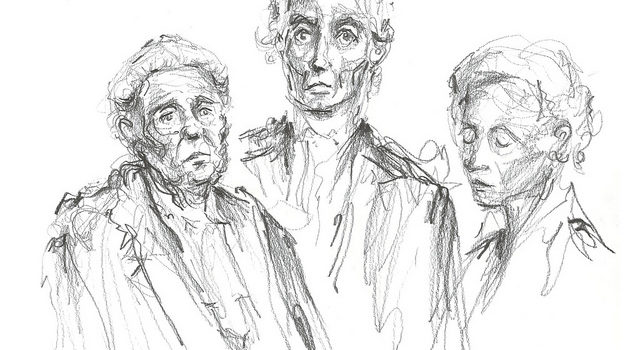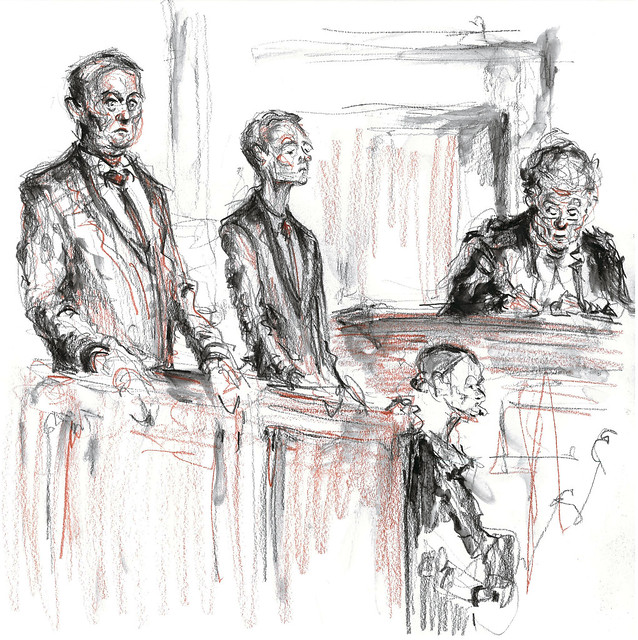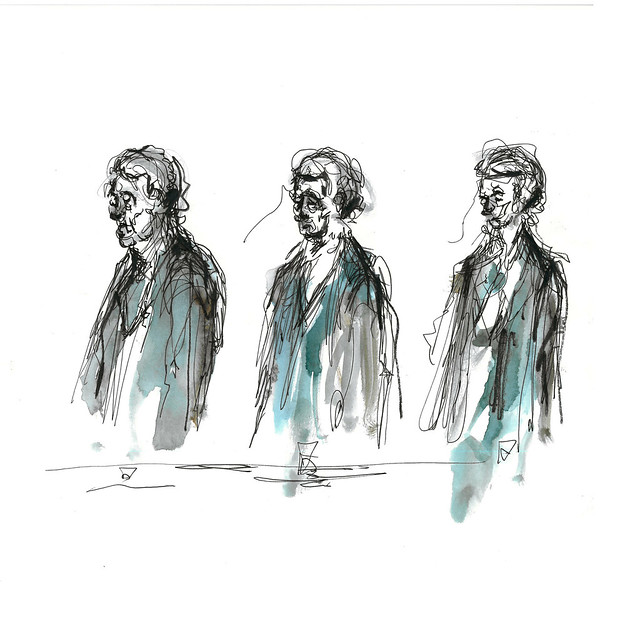 Play
Play
Drawing The Turing Trial
- by Hwa Jung
Robin Sukatorn is an artist and illustrator based in Manchester, who specialises in live drawing scenes from the political, civic and cultural world around him. He write about his experience as the courtroom sketch artist during Regina v Turing and Murray
As I sat ready to draw the opening performance of Regina v Turing and Murray in the historic courtroom of the Knutsford Crown Court, now The Courtroom Hotel, I was struck by the novelty of the opportunity I had before me.
In the United Kingdom, based on a provision of the 1925 Criminal Justice Act, it is expressly forbidden not only to take photographs but 'to make a portrait or sketch' of any person- whether a juror, judge or witness- within a courtroom. This includes drawing individuals as they enter and leave the courtroom, and even extends to drawing in any other part of the building or precinct of the courtroom.
 This was true at the time of the Turing trial and remains so to this day, with the only exception in the UK being the Supreme Court, which was exempted from the rule by the 2005 Constitutional Reform Act- and where I've had the exciting experience of drawing live myself, most memorably during the historic Article 50 hearing in December 2016.
This was true at the time of the Turing trial and remains so to this day, with the only exception in the UK being the Supreme Court, which was exempted from the rule by the 2005 Constitutional Reform Act- and where I've had the exciting experience of drawing live myself, most memorably during the historic Article 50 hearing in December 2016.
For the most part, however- when you see a courtroom sketch of a British criminal or civil trial, give pause to the thought that the drawing was committed from memory, outside the courtroom, and most likely at great speed whilst the media eagerly awaited the image for publication.
To be sat drawing in the front row of a courtroom myself, witnessing a live re-enactment of the historic and poignant Regina v Turing and Murray trial in the very room it took place 65 years ago- with the freedom to put pen and pencil to paper, and with the knowledge that such an act would have been illegal during the real trial- was a truly remarkable and humbling experience.
As the audience was transported back to 1952, I observed and drew as Judge Frazer Harrison- played with formidable authority by retired judge Graham Cliffe- presided over the courtroom from the bench; as the defendants Alan Turing and Arnold Murray- portrayed with stirring performances by Robert Burton and Sam Rees respectively- stood and spoke to the charge of committing so-called 'gross and indecent acts' from the witness stand; and as the gaggle of barristers presented their arguments dramatically to the court- often in startlingly archaic language to today's ears.
In my work as a live 'reportage' illustrator, I am interested in capturing a sense of the scene before me. Rather than drawing a precise, photographic reproduction, I focus more on documenting the gestures, expressions and movements of the individuals present, and on reflecting the energy, the environment and the key moments and features of the scene I am witnessing. This is what I was looking out for in the Knutsford courtroom, and my hope is that I've succeeded in some way to reflect the scene through my drawings.
 As an observer I often find myself engrossed not only in the task of drawing but in following the drama of the scene itself. Indeed this is an integral part of the process of serving as a live witness and reportage illustrator: responding intuitively and authentically to the subject-matter at hand and reflecting this in the drawings- whether consciously or subconsciously- by honing in on particular characters, expressions, moments and exchanges.
As an observer I often find myself engrossed not only in the task of drawing but in following the drama of the scene itself. Indeed this is an integral part of the process of serving as a live witness and reportage illustrator: responding intuitively and authentically to the subject-matter at hand and reflecting this in the drawings- whether consciously or subconsciously- by honing in on particular characters, expressions, moments and exchanges.
The experience of witnessing the Turing trial in person, re-enacted with the same words and in the same room as the original trial from 1952, really brought home the reality of what both Turing and Murray experienced and endured: judgement, shame, ostracisation physical detention and punishment imposed by an intolerant society- experiences which countless LGBTQ+ individuals have shared throughout history and which tragically continue all over the world today.
For me, as a reportage artist but also as someone who today has the privilege of living and loving freely and openly in a comparatively tolerant and progressive society, Regina v Turing and Murray was a fascinating, moving and socially important performance to witness and draw, and a poignant reminder of the historic and present-day experiences of LGBTQ+ individuals around the world, of the progress we have made in British legal, political and social norms, and of the significant role for the arts in keeping these stories alive.
Robin has recently completed a two- year MFA in Illustration from the Manchester School of Art, and in 2016 he received the John Ruskin Prize Student Award for a reportage drawing of Jeremy Corbyn speaking outside Manchester Cathedral. You can follow his ongoing reportage project, Drawing Democracy, on social media and on his website: www.drawingdemocracy.com